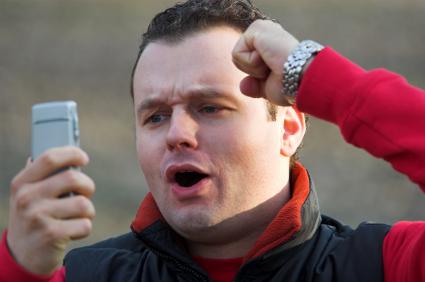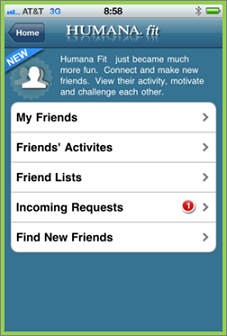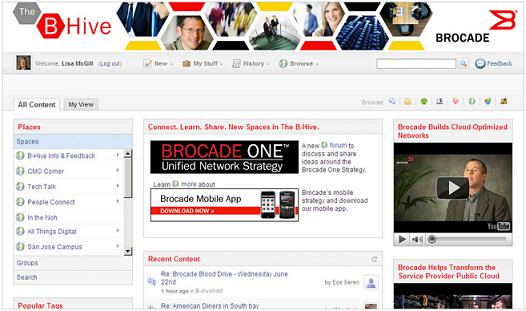Entries in mobile health and wellness texting (15)
Personalizing the Mobile Experience to Drive Consumer eHealth Engagement
 August 8, 2011
August 8, 2011 At the recent World Congress mHealth Summit, I led a panel called “Personalizing the Mobile Experience to Drive Consumer Engagement”.
Why is mobile so important and why does it need to be incorporated into all consumer health & wellness engagement strategies?
Pew Research’s May report found that “83% of US adults have a cell phone, and 42% of them own a smart phone”. As mobile phone ownership grows so does the consumers’ expectations about using this device to plan, manage and monitor their personal lives. Consumer- driven companies across financial services, retail, media and entertainment are designing creative ways to engage the consumer through a valuable mobile experience.
Within healthcare, mobile is a cost effective and efficient way to not only generate but also sustain consumer engagement.
Here are several strategic considerations that I presented while introducing the panel topic.
1. Segmentation & Customization. Once a company moves beyond enabling mobile access for all target users, they must think carefully about the varying needs and mobile usage profiles of their different consumer segments. Consider consumer segments which have high mobile technology usage.
Pew Research found that over 87% of minorities such as African Americans and Hispanics have mobile phones and they are more likely than whites to send/receive text messages, use the internet on their mobile phones and have smart phones. What about a mobile texting program educating them about their health condition or motivating them to engage in preventative care?
Frequent business travelers stay connected to their company, customers and family through their mobile phones and tablets. A recent Columbia University study showed the association of business travel and cardiovascular disease. According to the study, this may be caused by their poor diet, lack of exercise and sleep as well as stress. Imagine how mobile can be used to help these travelers manage their health issues and make better decisions while on the road.
Over 75% of teens have a mobile phone and more than half are texting every day based on Pew research. Can you send mobile messages to teens to educate them about staying fit or informing them about ways to manage their diabetes? There is also opportunity on the mobile apps front. I recently participated on a project envisioning mobile solutions to support the mental health of (college) students to avoid depression.
How is Highmark approaching segmentation? Highmark utilizes Forrester’s Technograph Segmentation to prioritize their mobile initiatives. Panelist Lisa Fitting, Director Client Engagement mentioned that when Highmark conducted segmentation research across their member base, two key segments emerged-- “Connectors who use their mobile phone for work and are productivity- oriented” and “Communicators who regularly use SMS” and often use other digital communications. Highmark is using this insight to define mobile initiatives based on these preferences. They also plan to come out with mobile applications targeting specific needs such as “fitness, weight management, diabetes, medication”.
2. Multi-Channel Experience. As consumers move about their daily life, they move from channel to channel. Teens put down their mobile phones when they pull out their laptop computers. When they are through interacting via their computer, it is important that their next mobile interaction reflect their latest online activities.
Humana conducts user experience research to better understand how different types of users interact with their Humana Fit application through their mobile phones and computers. Panelist Tony Tomazic, Director of Consumer Innovation at Humana explains “we understand the strengths of mobile. Through research, we have learned how consumers want to use their mobile phone for tracking and communications regarding personal health and fitness (e.g. saving episodes of activity, receiving reminders and alerts), whereas consumers prefer to use their computers to manage more complex and visual planning of their goals and gather information from their other external devices.”
3. Personalization in Context. While carrying their mobile devices, consumers can use them to receive reminders, review educational messages, track information (e.g. mood, pain levels, fitness and nutrition) as well as search for information to make decisions while on the go.
"Healthline brings both personalization and contextualization to the consumer", explains panelist Ryan Tarzy, VP Business Development. “Aetna members view search results that are both contextual to the issue they are researching (e.g. diabetes), but also personalized based upon their personal health record, location, and covered benefits”.
As you develop your mobile health and wellness strategy, think about the needs of your various consumer segments and their mobile technology profiles. Consider their multi-channel experience of which mobile is only a part. And determine how you can design a mobile strategy which brings new value to the consumer through personalization within the context of their current health, plan coverage and location.
Have you read the Seven Mobile Health Engagers?
Employee Engagement Series: Employee Social Online Community, Mobile & Employee Wellness Advisory Council
 June 20, 2011
June 20, 2011 “My participation in online communities (within BHive) provides me with a platform to engage & converse with my peers and build camaraderie based on shared interests. Through ‘Tastebuds’, our online community for foodies within Brocade, I have engaged like-minded individuals to discuss recipes, exchange restaurant reviews and promote healthy eating, resulting in a sense of belonging centered around a common interest.”
BHive is a private online employee social community. BHive is leveraged to help promote many wellness initiatives which helped make Brocade one of the top 100 companies to work for, making Fortune’s 2011 & 2010 list.
Within BHive, employees friend and follow each other as well as earn points for posting and answering questions and contributing to discussions. The most popular topics that Brocadians are discussing online are WellFit (includes ViveCoach challenges, Sports Groups), WIN (Women in Networking), BInvolved (volunteerism & community involvement) and San Jose Campus (employees posting photos from various work events like the annual Chili Cookoff). Brocade uses BHive to gather information from employees through polls and discussions and generate engagement in offline company and community events. During May, employees worldwide participated in “Bike to Work” and posted their photos online.
With the ViveCoach platform, Brocade engages employees through their mobile phones. During social challenges, employees receive mobile messages about additional challenge points needed by their team, team work-out reminders, healthy nutrition or fitness tips, reminders (“drink lots of water” or “take the stairs”), team banter and leader board status. Brocade had a team of remote employees join a recent challenge and they are planning a competition that includes spouses and family members. “We believe that it is important to include employee’s family members so these lifestyle changes become more sustainable”, explains Lisa McGill, VP, Worldwide Human Resources at Brocade.
What is the secret for being on the leading edge of employee engagement? In June 2010, Brocade launched their WellFit Council with 15 representatives from all departments and geographies. These employee advisory Council members are divided into four work teams (Health & Wellness, Fitness, Education & Communities) and meet once per month to provide input and guidance on wellness related events, education, communication channels/content and metrics to motivate and measure engagement at Brocade. Each employee member leverages their own employee network to bring additional ideas and feedback to the Council meetings and into the dedicated online WellFit Council discussion area within BHive. “Being part of the Council has been a great experience and for me it has really affected how I manage my health, wellbeing and work-life balance. Some of the ideas are even rubbing off on my husband”, shares one WellFit Council member.
Learn more about Brocade’s successful initiatives to drive employee engagement at the Healthcare Unbound conference panel, "New Directions in Employee Engagement: Competition, Coaching, Community and Compensation".
Multi-Channel, Multi-Touch Approach to Maximize Member Engagement
 January 4, 2011
January 4, 2011  Innovative health plans are experimenting with an expanding set of marketing channels to motivate members including mobile and social media. They are getting smarter about synchronizing these touches for maximum member response.
Innovative health plans are experimenting with an expanding set of marketing channels to motivate members including mobile and social media. They are getting smarter about synchronizing these touches for maximum member response.
In addition to staying aligned with their members’ evolving needs, Plans must reach members where they are, in a way that is ‘meaningful’ to that member to motivate healthy outcomes.
During this moderated panel discussion, you will learn how Plans are:
- Understanding the consumer’s changing behavior in this social and economic environment
- Synchronizing their segmentation and personalization strategies across the communication channels
- Testing new media and mobile approaches to build member loyalty
- Delivering consumer education to address member confusion with plan and care options
Moderated by Sherri Dorfman, CEO & Consumer eHealth Engagement Specialist, Stepping Stone Partners
Panelists:
- Molly Goins-Cox, Head of Member Experience, Aetna
- Kevin Riley, VP of Innovation and Consumer Health Solutions Group, BCBS of Florida
- Mark Scrimshire, Director of Internet Channel Strategy, CareFirst BCBS
Successfully Engaging Teens Through Mobile For Better Health
 July 16, 2010
July 16, 2010  Over the weekend I had dinner with close friends who told me about their teenage daughter and her sleepover with few girl friends. “All three of the girls had their cell phones lined up and plugged in a charging side by side on the night table”. Even when they are sleeping, teens keep their cell phones close by. While awake, these “digital natives” are continuously connected which provides opportunities for reaching and engaging teens in their health.
Over the weekend I had dinner with close friends who told me about their teenage daughter and her sleepover with few girl friends. “All three of the girls had their cell phones lined up and plugged in a charging side by side on the night table”. Even when they are sleeping, teens keep their cell phones close by. While awake, these “digital natives” are continuously connected which provides opportunities for reaching and engaging teens in their health.
Strong Statistics on Teen Mobile Usage
In Pew’s latest study of 12- 17 years old teens, there are interesting insights about teen's use of mobile technologies:
- Teens Have Mobile Phones. “Three-quarters (75%) of teens now have a cell phone”.
- Teens Texting for Connection. “Fully 72% of all teens – or 88% of teen cell phone users — are text-messages. That is a sharp rise from the 51% of teens who were texters in 2006.”
- Teens Texting Daily. Each day, 54% of teens text compared with 25% using social networking sites.
- Girls Texting Much More. Teenage girls tend to send and receive more texts each day, 80 compared with 30 for boys.
- Minority Teens Use Mobile for Internet Access. “44% of black teens and 35% of Hispanic teens use their cell phones to go online, compared with 21% of white teens”.
Influencing the Health of Mobile Teens
Organizations have been researching and piloting programs to learn how to impact the teen’s health behaviors for better outcomes.
After a successful pilot, the Murdoch Children’s Research Institute (MCRI) with the Telstra Foundation rolled out a program for teens (and young adults) that uses mobile to monitor their mental health including stress levels, coping strategies, dietary and fitness factors.
The NY Times reports that Mount Sinai Hospital has researched and learned that sending text messages to young liver transplant patients can improve their medication adherence and “avoid life-threatening complications”.
Partner’s Center for Connected Health recently ran a pilot with pregnant teens with the goal of using mobile for outreach. OB Case management sent SMS text messages about proper pre-natal care and regiments. These messages were educational and prompted the teens to take an action such as attend an office visit. “We learned that the texting strengthened the relationship- 83% reported feeling more supported by the health center case manager”, explains Alex Pelletier, Team Lead, Program and Product Development at Partners. More about this pilot from Alex on my upcoming World Congress panel, Generating Mobile Engagement Through Consumer Segmentation, Crowd Sourcing and Personalization.
Future Mobile Teen Projects:
The Robert Wood Johnson Foundation recently granted $2.4M to mobile health project including one from the San Francisco State University – San Francisco, California targeting teens from low-income backgrounds who experience much higher rates of obesity. To help these teens manage their obesity and depression, the University will evaluate the capturing of observations of daily living (ODLs) through smart phones and sharing of the data with their care team for planning and care management.
Teens are dealing with many different health issues while on the go managing their busy lives. Their health concerns span their physical and mental health which may include juvenile diabetes, obesity, asthma, sexual health problems and even autism.
How is your organization targeting this segment of “digital natives” around health? How are you leveraging mobile technologies to reach, influence and impact them to have healthier bodies and minds?
Generating Mobile Engagement Through Consumer Segmentation, Crowd Sourcing and Personalization
 June 14, 2010
June 14, 2010  World Congress Leadership Summit on Mobile Health, July 29th & 30th, Boston
World Congress Leadership Summit on Mobile Health, July 29th & 30th, Boston
Healthcare organizations are taking advantage of the consumer’s strong demand for smart phones and mobile health apps. They are piloting new health initiatives through SMS (text), Mobile Web and Mobile Applications and learning about the opportunities and barriers to accelerate adoption and usage.
Industry leaders understand the need to tailor their mobile offerings to specific consumer segments and to personalize the experience to sustain engagement.
During our session, you will learn how our panelists are utilizing mobile to enable care access and compliance, deliver health education as well as influence and track health behaviors. They will show examples of their mobile health initiatives and share insights they’ve gained from segmentation, personalization and crowd sourcing. The panelists will also offer their vision for mobile health opportunities in the near future.
You will gain a unique perspective from companies on this panel which are bringing mobile health offerings to consumers directly as well as through the healthcare delivery and health plan channels. As you will see, each business channel has its own sources of value to engage the consumer.
Facilitator:
Sherri Dorfman, MBA, CEO, Consumer eHealth Engagement Specialist, Stepping Stone Partners
Panelists:
- Bud Flagstad, Vice President, Strategic Initiatives, UnitedHealth Group
- Julie Kling, Mobile Strategy Group, Humana
- Tim Kieschnick, Director, User Experience Internet Services Group, Kaiser Permanente
- Alexandra Pelletier, Team Lead, Program and Product Development, Center for Connected Health, Partners HealthCare System
- Benjamin Rubin, CTO and Co-Founder, Zeo Inc.





